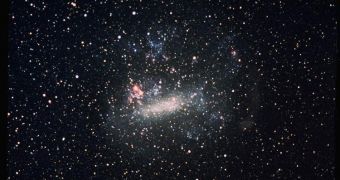According to the conclusions of a new scientific study, it would appear that dwarf galaxies are entirely dominated by dark matter, and also that the elusive form of matter may exist in the form of dwarf stars.
The investigation has interesting implications of models seeking to explain the nature of dark matter. But scientists say that findings made while investigating dwarf galaxies could also lead to a fundamental altering of our perception of gravity.
University of Michigan expert Mario Mateo and his colleagues conducted the new study, which was carried out using the NASA Chandra X-ray Telescope. The dwarf galaxy NGC 1569 was the primary target for research.
The object, which is located about 7 million light-years away from Earth, has some interesting properties. These include the fact that massive bubbles filled with chemicals can be seen both above and below its disk.
By using Chandra, the experts were able to determine for the first-time ever the concentration of elements such as silicon, oxygen, magnesium and neon in these bubbles. The way the elements are distributed in the galactic disk was also determined.
NGC 1569 has been undergoing bursts of stellar formation for the past 20 million years, and this is visible in the way the dwarf galaxy looks. Massive stars continuously form and explode just millions of years later, in tremendously powerful supernova events, Daily Galaxy reports.
Astronomers on the research team say that the study provides clear evidence that small galaxies are dominated by dark matter to a great extent. “These galaxies show a problem right from the center. The velocity doesn't get smaller. It just stays the same, which is eerie,” Mateo explains.
“We have more than doubled the amount of data having to do with these galaxies, and that allows us to study them in an unprecedented manner,” adds Harvard-Smithsonian Center for Astrophysics (CfA) expert Matthew Walker.
“Our research shows that dwarf galaxies are utterly dominated by dark matter, so long as Newtonian gravity adequately describes these systems,” the scientist goes on to explain.
“Dwarf galaxies are not much to look at, but they may really alter our fundamental views on the nature of dark matter and, perhaps, even gravity,” Mateo adds.
Interestingly, we have two dwarf galaxies located within the Local Group – the Large and Small Magellanic Clouds. Other similar galaxies may exist around the Milky Way, and studies are now ongoing to detect them.

 14 DAY TRIAL //
14 DAY TRIAL //